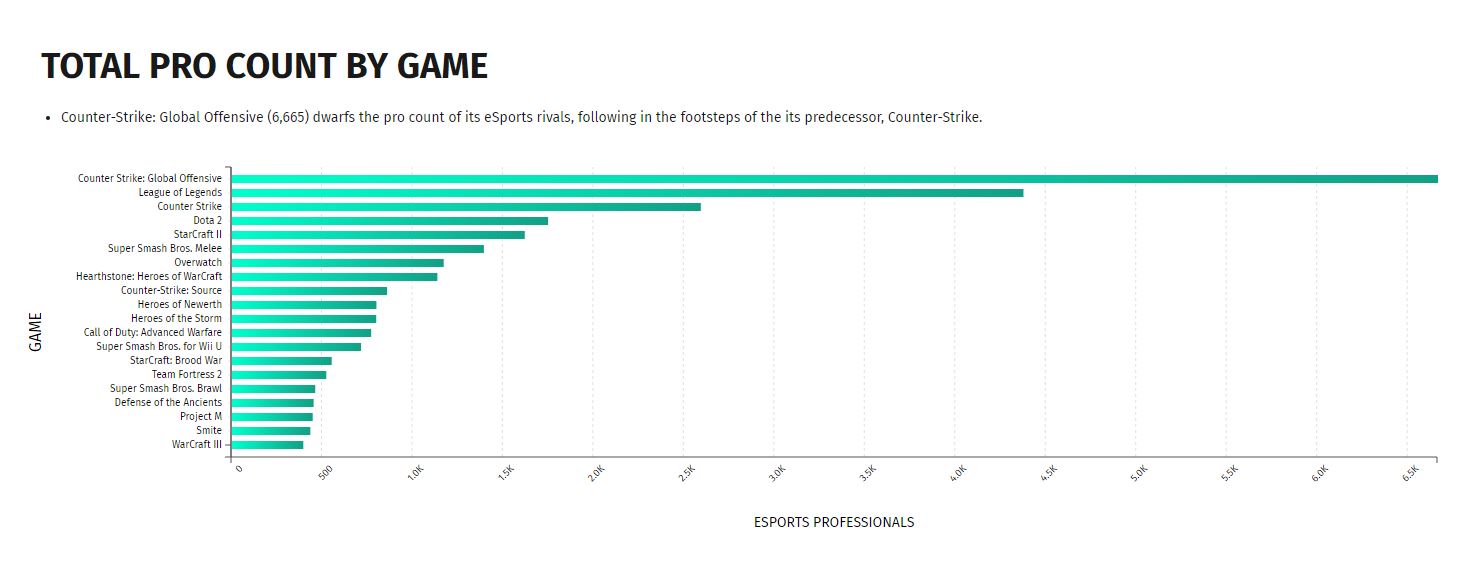Bookmaker Unibet has released an updated version of its “Champions of Esports”, a tool showing various statistics from across esports history.
The nifty and easy to use tool takes viewership data from Statista and player, game and country data from esportsearnings.com, Newzoo, Twitch and TeamLiquid.

It offers a variety of statistics from viewership, to average tournament winnings all the way to player nationalities and player density (i.e. amount of professionals per million population). The infographics on top earning players and teams help visualise what otherwise is just a long list of numbers.
Although they’ve cited sources, it’s fairly difficult to tell exactly where the numbers come from. This is a general gripe at most things in esports, and a frustration that many have even had with Newzoo forecasts – there’s no transparency in where or how the numbers are obtained.
Whilst the infographic looks lovely and to anyone looking for a snapshot of esports growth or breakdown of statistics they may serve some purpose, a majority of the figures need to be carefully considered for what they are. Again, this isn’t just the case with the Unibet tool but across the whole of esports data.

Certain statistics such as “pro count by game” offer little explanation as to who, or what constitutes a professional with Counter-Strike: Global Offensive an anomaly with over 6,665 “pros”. The difficulty is in deciding what makes someone a professional? There are definitely not that many players making a comfortable living by playing CS:GO. Switch to the “average age of a pro” graph and it suggests there are 1,425 professionals in total across esports to take a sample from. Something doesn’t quite add up.
It suggests Counter-Strike: Global Offensive gained over 3,000 professional players between 2015 and 2016 which seems a little ambitious at a stretch – unless anyone else has charted the emergence of 600 professional teams alone in just a year?
Certain statements above the infographics also tend to lack credibility. One reads:
“Despite only being released in the last few years, Heroes of the Storm (June 2015) and Hearthstone (March 2014) have breached the top 10 and look certain to overhaul Counter-Strike by the turn of 2018.”
First off, they’re comparing Hearthstone and Heroes of the Storm to Counter Strike. Not Counter-Strike: Global Offensive or Counter-Strike: Source, just Counter Strike. If we’re to assume that this means the 1.6 iteration of Valve’s popular FPS title, then there hasn’t been an esports scene for a long, long time. So of course two active titles could overhaul it.
Then again, stating that Heroes of the Storm and Hearthstone (which according to their graphs are $3.3m and $3.6m behind Counter Strike respectively) will overhaul Counter Strike also seems bold without reason. It’s safe to say that the Heroes of the Storm scene is hardly blossoming and its prize pool growth may stagnate. It’s brave, and completely unnecessary, to claim that Hearthstone will have over $3.3m in prizes this year.
Another smaller gripe is the statement:
“Owing to the performances of Wings Gaming in Dota 2’s The International tournaments, China have topped the winnings leaderboard since 2014”
Wings Gaming won The International (TI) in 2016, and whilst China’s rise to the top of the tournament winnings chart was down to The International winnings it was the first/second place of Newbee and Vici Gaming that delivered it. Wings Gaming have only competed in one TI and it doesn’t take a genius to research it.
Esports Insider says: On premise alone, it’s a nice idea. The continued issue around lack of transparency with esports data is clear though and although this tool is pleasing on the eye – the question is what does it, or what is it, trying to achieve?

